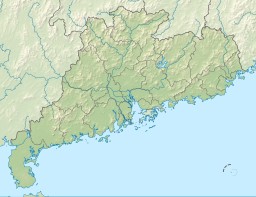Shenzhen Reservoir
| Shenzhen Reservoir | |
|---|---|
| 深圳水库 (Chinese) | |
 View of Shenzhen Reservoir | |
| Location | Luohu District, Shenzhen, Guangdong |
| Coordinates | 22°34′55″N 114°09′44″E / 22.582076°N 114.162084°E |
| Type | Reservoir |
| Primary outflows | Sham Chun River |
| Basin countries | China |
| Built | March 1965 |
| First flooded | March 1965 |
| Surface area | 60.5 square kilometres (14,900 acres) |
| Water volume | 45,770,000 cubic metres (12.09×109 US gal) |
Shenzhen Reservoir (simplified Chinese: 深圳水库; traditional Chinese: 深圳水庫; pinyin: Shēnzhèn Shuǐkù) is a reservoir located in Luohu District, in southeastern Shenzhen in the southern China. Shenzhen Reservoir is the largest man-made lake in Shenzhen. It belongs to the first grade water source protection area (一级水源保护区) and is part of Shenzhen's water supply network. The reservoir's drainage basin covers about 65 km2 of urban and forested land in southern Guangdong province.

The reservoir borders Donghu Park and Fairy Lake Botanical Garden and drains the western slope of Mount Wutong.[1] The reservoir discharges into Sham Chun River, the natural border between Hong Kong and Mainland China, together with the Sha Tau Kok River.[2]
History[edit]
Shenzhen Reservoir was built in March 1965 for irrigation and drinking water purposes.[3]
Public access[edit]

Shenzhen reservoir is open to the public from 6:00 pm to 9:00 pm every day.
Shenzhen Reservoir is a popular recreation area for hiking and tourism.
Nearby attractions include Donghu Park and Fairy Lake Botanical Garden.
Transportation[edit]
Take bus No. 3, 17, 23, 29, 211, 308, 320, 351 to Shuiku Bus Stop (水库站).
References[edit]
- ^ 梧桐山风景区或扩容 深圳水库、布心山郊野公园纳入. sznews.com (in Chinese). 2015-10-30. Archived from the original on 2016-10-10. Retrieved 2016-10-07.
- ^ 深圳水库泄洪道竟成野泳乐园. sznews.com (in Chinese). 2012-05-14.
- ^ Bo-Ping, Han; Zhengwen, Liu (18 September 2011). Tropical and Sub-Tropical Reservoir Limnology in China: Theory and practice. Springer. ISBN 9789400737976.
External links[edit]
 Media related to Shenzhen Reservoir at Wikimedia Commons
Media related to Shenzhen Reservoir at Wikimedia Commons

